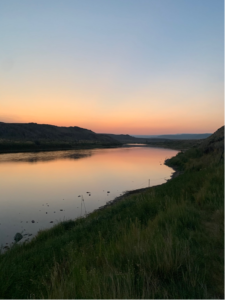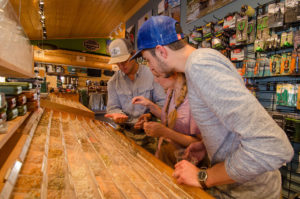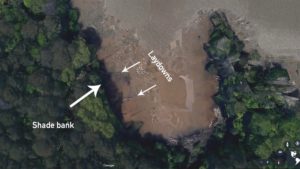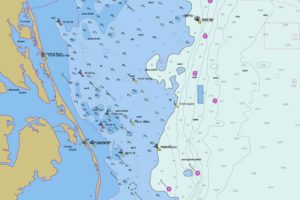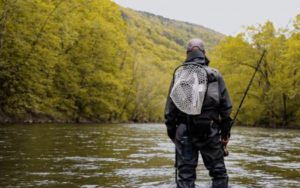After a long summer of doing a whole lot of nothing due to Covid-19 restrictions, my friends and I decided that it was our duty to do something fun before classes resumed in the fall. After careful deliberation, it was decided that we would do a three day fishing trip somewhere within driving distance of Denver, Colorado. The only question was where. I promised the group that I would do some research and figure out which areas might give us what we were looking for. While our main goal was to catch a ton of fish, we also wanted to find a place that would offer beautiful scenery. I took to Google checking everything from local fishing reports, to U.S. water data, and even old blog posts to get a sense of what areas might be fishing at that time. Before long, I had devised a plan that I felt would give everyone involved the best experience possible. I had read about a stretch of the North Platte River near Alcova, Wyoming a while back referred to as “the Miracle Mile” for its beautiful landscape and fat aggressive trout. Recent fishing, and weather reports all pointed to ideal conditions for our slotted three days. Once everyone was on board, we began making preparations for our three day journey.
With our gear ready and enough food for the three days at the Miracle Mile, we set out for Wyoming. We made sure to stop in Alcova, which was the only civilization within 40 miles of our destination. There we sought advice on bugs and tactics from the local fly shop, and got some last minute supplies and firewood from the general store. It is important to be sure that you have every bit of gear you might need when venturing 40 miles out of cell reception. That includes, but is not limited to, a tent, sleeping bag/pad, food, water, firewood, lighter, toilet paper, and plenty of beer. As I watched the small smidge of a town fade into the rearview, I felt a sense of freedom take over the car. It was not long before the cracked pavement crumbled into dirt roads. We saw more wildlife than people on the drive to ‘the Mile’, as the fly shop owner called it. In fact, we did not see any people at all. Herds of mule deer and pronghorns danced over the hills as our trucks left a trail of dust billowing behind us. After about an hour of driving we finally saw the emerald blue river appear out of the plains, as if by magic.
This section of the North Platte River weaves through desert, prairie, and canyons giving way to some of the most breathtaking scenery you are likely to find anywhere in the U.S.. With dispersed camping allowed on both sides of this entire stretch of river, we explored a bit before setting up along a grassy bank with a pre-made fire pit overlooking some prime dry fly water. We began to hastily set up camp, as all of us were eager to get out and fish. Before we could even get a tent up, someone had spotted a rising fish and began setting up their rod. Camp set up would have to wait until later as the rest of us began to follow suite. The Miracle Mile offers anglers a plethora of different types of water to fish with very little angling pressure. While we set up camp along a slow and slick run, the Mile also holds long riffles, large boulder fields, and plunge pools 20 feet deep. Paradise to any fly fisher looking to cover multiple water types in a single day.
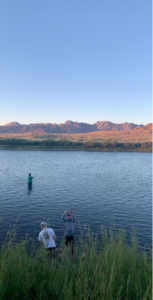
With only a few hours of daylight to fish and set up camp, we decided to fish within walking distance of camp on day one. It did not take long before all of us were into fish. Browns, rainbows, and cutbows were all eagerly taking large hopper flies and streamers. Even some of the beginners on the trip were having no trouble finding fish. We found that most fish were holding along undercut grassy banks similar to the one where we had set up camp. As we began trickling back into camp, it was clear by the smiles on our faces that we had all found success. The bright orange sun sank behind the hills as we finished setting up, revealing a sky full of stars unlike anything I had ever seen before. It seemed like every time I looked up from the fire I would see multiple shooting stars. We sat around the fire deep into the night drinking cheap beer and filling our bellies with hot dogs. Each of us slept well knowing that we had two more days in heaven.

We awoke early the next morning as the sun cleared the mountains, illuminating the valley. It was not hard to get out of bed knowing what the day had in store for us. With bacon and eggs sizzling over the fire, we made a plan for where we would fish that day. We decided on a stretch of river just a short drive from our campsite where the river drops into a canyon and is lined with tall granite walls. We traversed our way down into the canyon and it did not take long before we were into the fish once again. It seemed like there was an amazing pool stacked with fish behind every boulder and bend. That day we decided that we would “live off the land” and cook some fish for lunch, as was permitted on this stretch of river. We kept a few eating sized rainbows, about 12 inches each. Once we had the trout dispatched and cleaned, we added some salt, pepper, and lemon juice before wrapping them in tinfoil and throwing them directly into the fire. As we sat on the riverbank cooking our catch, I took a moment to take in the unbelievable scenery. It also did not hurt that we had the entire canyon to ourselves. We each enjoyed our fish before heading out to find the afternoon bite. In the afternoon we ventured deep into the canyon where the walls became extremely narrow. Soon we forgot all about the fish and focused on exploring the canyon. We found some amazing rock structures, and even a place to cliff jump. When we were sitting around the fire at camp later that night, I found myself feeling incredibly lucky. This day had definitely been the highlight of the trip.

Due to some late night campfire activity, we slept in the next day. When we awoke, we all agreed that we wanted to stay close to camp and relax. Some of the group walked downriver to see how the fishing was while the rest of us decided to do some exploring in our cars. We had stumbled upon an old off-roading trail on our way back to camp the previous day and were keen to see where it might lead us. We had made it about a mile down the trail before we saw another campsite. As we drove by a man came out to great us. To all of our surprise he told us that he had been living out there since the Covid-19 pandemic began in America. I was amazed to hear that we were the first ones to come down the trail since he had set up camp months before. It is true that you never know what you might find when you go out and explore. I can’t blame him for wanting to wait this whole thing out in such a beautiful place. While sitting around the fire on the final night, I could not help but feel a bit sad to be leaving in the morning. Not only had we found amazing fishing, but also a break from reality in a time that is putting everyone to the test. I woke up early the next morning to watch the sunrise before folding up my tent and packing the cars for our return home. The glassy river reflected the peach sky in a truly spectacular way. As we drove away and I watched the river disappear behind the rolling hills, as the realization set in that we were heading back to reality.
